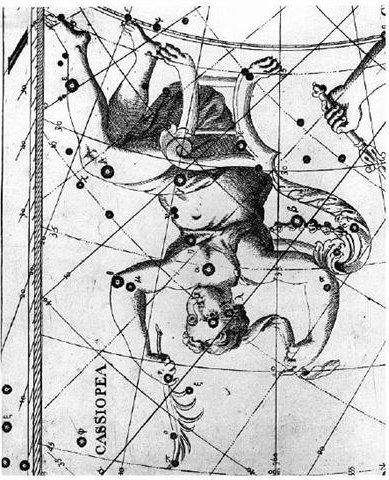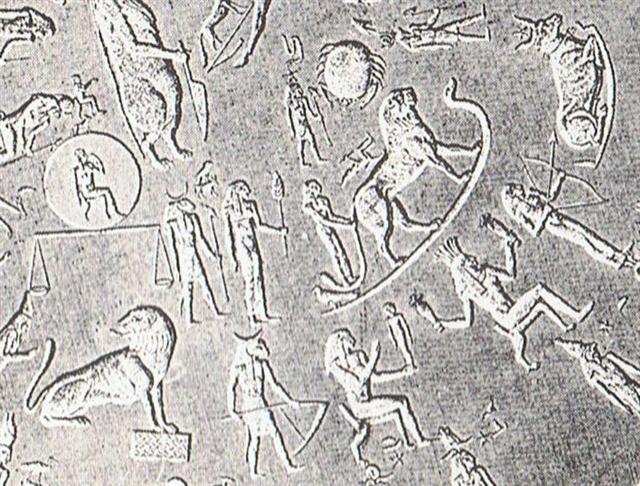2. The phenomenon of her being upside down needs to be understood. I cannot find any reasonable explicit explanation in Allen and perhaps the meaning was lost a long time ago. But I guess Flamsteed's picture is more close to truth than the version in Urania's Mirror:
The lion's paws of the chair is at the top end of the figure, a sign which I interpret as 'the old Sun king has been toppled'. Caph is very close to 'time zero', but once upon a time the whole figure would have been straddling this cardinal point. Thus the old ruler would have to go (be washed away by the river of time) and a new one 'ignited'. A new one must be born, and with a bit of imagination we can see how Flamsteed could have illustrated this birth - the head is already out. Certainly there are arms and not legs surrounding this head, but in a way they must be arms because the solar baby is born with arms. The legs belong in autumn:
In The Mouth of the Fish I presented a peculiar picture of Adam and Eve and the Serpent:  ... The strange arms which are drawn like legs are meant to make us see legs. In spring Sun is gradually growing in power and stature. Later he is initiated and comes to know his female queen. Not until then is he ripe enough to change from 'eating' to 'giving his fruit'. The spring phase needs hands to grab with, but legs come later ... Both the king's paws and the queen's feet are in the Cassiopeia constellation at the top end. They are going down together (the lion and the queen). Also in the round Dendera zodiac the queen is sitting on her lion throne:
First she is the lady archer (presumably killing Spring Sun), then it could be she who is sitting as ruler on the throne with lion's paws. Next a little boy has been born - time must run quickly in Egypt because not far after midsummer Sirius is making the Nile rise and causing the deluge. Ethiopia, the source of the Nile, is far up in the south, while in Babylonia and in most of the rest of the world, the deluge is caused by events far up in the north, at the other end of the sky roof. When the constellation Cassiopeia was drawn upside down it probably meant the time of the year when a new Sun was born: "Cassiopeia, or Cassiope, more correctly Cassiepeia, although variously written, is one of the oldest and popularly best know of our constellations, and her throne, 'the shinie Casseioppeia's chair', of Spencer's Faerie Queen, is a familiar object to the most youthful observer. It is also known as the Celestial W when below the pole, and the Celestial M when above it ..." (Allen) It would once, therefore, have been quite clear that the upside down position of M was a time indicator. W is the 23rd letter in the English alphabet, thus it can indicate the last phase of a cycle with 24 (= 0). M is the 13th letter. |


